Have you ever seen a cardinal in the wild? Many people consider these bright red songbirds to be a symbol of good luck. Others believe that seeing a cardinal means that a deceased loved one is watching over you. Regardless, cardinals remain one of the most popular birds among both enthusiasts and the general public. From their distinctive red color to the loud, brilliant vocalizations, cardinals delight bird watchers the world over. Of the many species of cardinal, the most well-known is the northern cardinal. Also known as the redbird, common cardinal, or simply cardinal, it is the bird most people associate with cardinals. However, there exists a number of birds that look like cardinals. These birds mimic the cardinal in terms of appearance or sound and may occur in the same regions. Given that, how can you know that the bird in your backyard is a true cardinal?
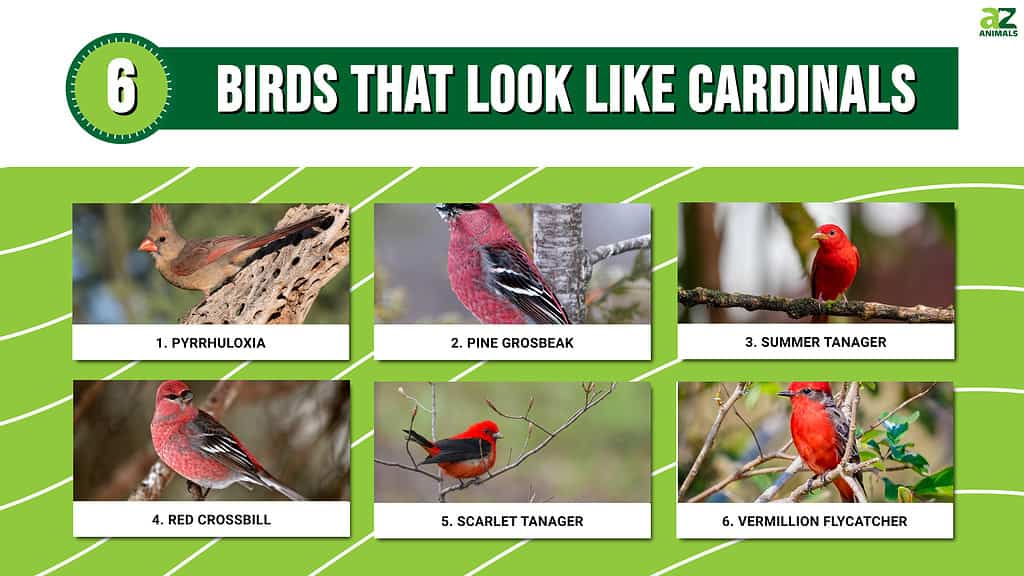
If you want help discerning a cardinal copycat from a real cardinal, you’ve come to the right place. In this article, we’ll discuss 6 birds that look like cardinals. We’ll also help you to figure out how you can differentiate one of these mimics from an actual cardinal. That way you can know for sure if the bird outside your window is a symbol of good luck or just another red bird. Like get to comparing, and take a gander at 6 birds that look like cardinals.
#6: Vermillion Flycatcher
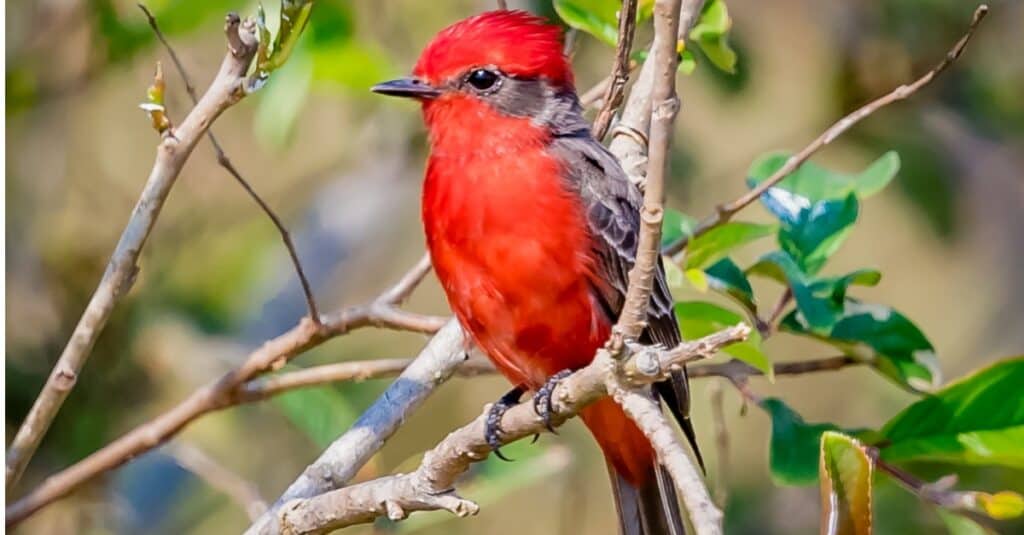
The vermillion flycatcher sports red and gray plumage similar to a cardinal’s.
©iStock.com/jocrebbin
The vermillion flycatcher is a small species of flycatcher in the Tyrannidae family. Like the cardinal, it lives in North and Central America, but rarely north of the southwest United States. It gets its name from its bright red coloration and habit of catching insects in midair. In Spanish-speaking areas, it also goes by the name mosquero cardinal, or “cardinal-colored fly killer.” You can differentiate a vermillion flycatcher from a northern cardinal in several ways. First, while a vermilion flycatcher’s throat is red, a cardinal’s is black. Second, cardinals sport a large crest on their head, whereas the crest on a flycatcher is much smaller. While they both eat grains and insects, the vermillion flycatcher’s diet relies more heavily on insects. Also, their vocalizations sound quite different. The vermillion flycatcher emits a trilling sound like ching-tink-a-le-tink. Meanwhile, the cardinal makes a clear, two-part whistle followed by a slower trill.
#5: Scarlet Tanager

The scarlet tanager does not sport the northern cardinal’s distinctive black face mask.
©iStock.com/bookguy
The scarlet tanager belongs to the same family, Cardinalidae, as the northern cardinal. However, it belongs to a different genus, Piranga, which is composed of tanagers in the cardinal family. Scarlet tanagers range throughout the eastern United States, Mexico, and Canada, and overwinter in South America. Unlike the northern cardinal, the scarlet tanager primarily subsists on bees. You can tell the two birds apart by comparing their bills. While the cardinal sports a thick, conical bill suitable for eating seeds, the scarlet tanager’s bill is much thinner. In addition, scarlet tanagers also lack the distinctive black face and throat markings of a cardinal. The red coloring of a scarlet tanager is generally darker than the coloring on a cardinal. Also, cardinals tend to grow slightly larger, measuring 8.3 to 9.1 inches compared to the 6.3 to 7.5-inch scarlet tanager.
#4: Red Crossbill
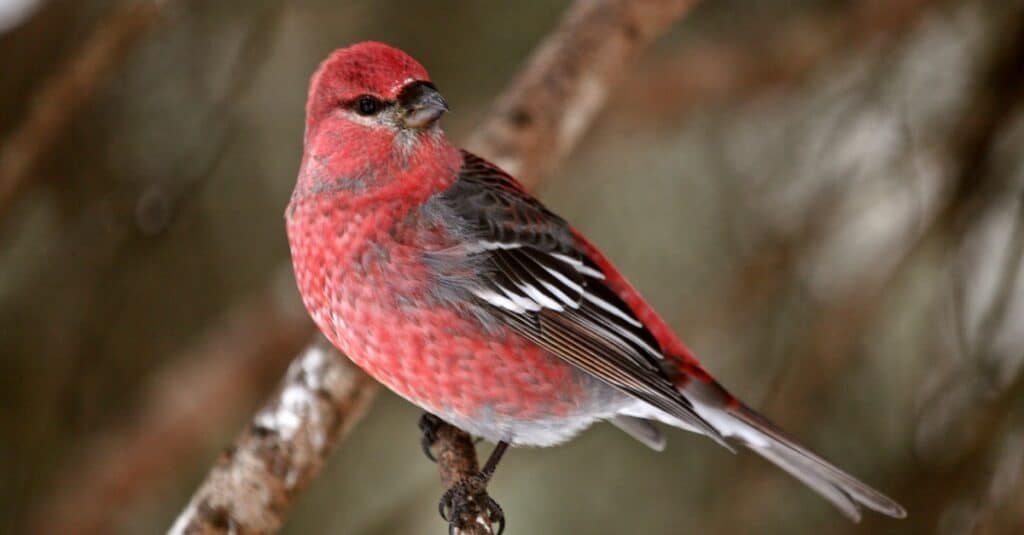
The red crossbill has a bill that overlaps, while the northern cardinal’s bill is thick and conical.
©iStock.com/bobloblaw
Also known as the common crossbill, the red crossbill belongs to the finch family, Fringillidae. They range throughout North America, Europe, and Asia, which means you can encounter them in the same regions as northern cardinals. Compared to a northern cardinal, the red crossbill’s color is more orange than red. While the red crossbill primarily feeds on conifer seeds, the northern cardinal eats a wider variety of foods including insects and berries. That said, the main difference between the two birds lies in the shape of their bills. The northern cardinal sports a thick, conical bill that enables them to eat fruits and insects. Meanwhile, the red crossbill possesses a crossed bill, with one half overlapping the other. This allows them to effectively break open hard conifer seeds, and is also where they get their name, “crossbill.” Just by looking at their faces, you can easily tell the two apart.
#3: Summer Tanager
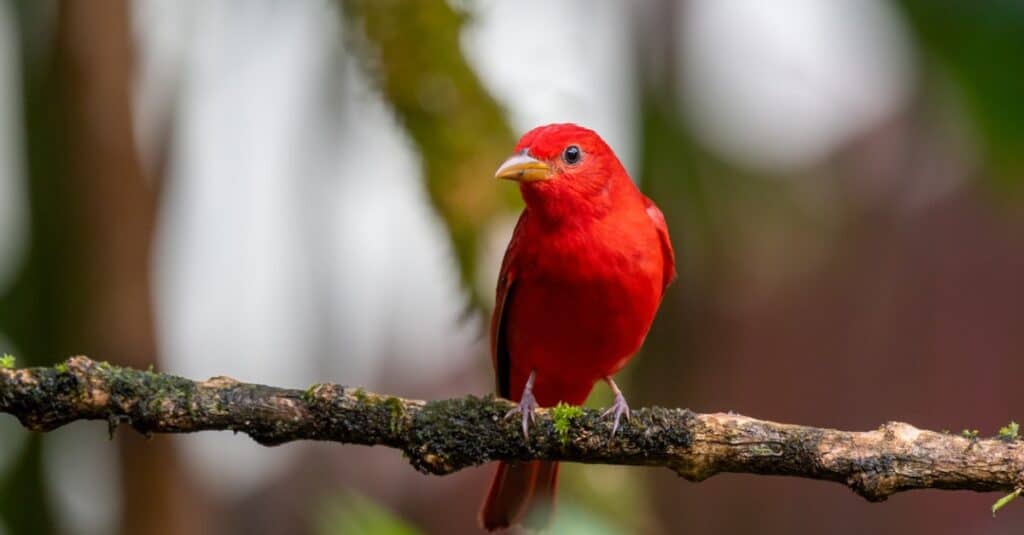
The summer tanager’s plumage is rose-red, while the northern cardinal’s is more of a vibrant red.
©iStock.com/Dave Kempe Photography
Like the scarlet tanager, the summer tanager also belongs to the tanagers in the Cardinalidae family. Its range includes most of the central and southern United States, as well as Mexico, Central America, and South America. While their color varies, they typically grow rose-red feathers, unlike the vibrant red color of the northern cardinal. Unlike the northern cardinal, the summer tanager primarily eats bees, although it also eats berries. Their vocalization is more similar to an American robin’s, which can help you discern its song from a cardinal’s. Aside from their color and sound, you can also tell them apart by their bills. Compared to the northern cardinal, the summer tanager’s bill is more stout and pointed. This makes them more well-adapted to eating insects, whereas the cardinal’s bill is designed to break open seeds. Based on these features, you too can differentiate between a cardinal and a summer tanager.
#2: Pine Grosbeak
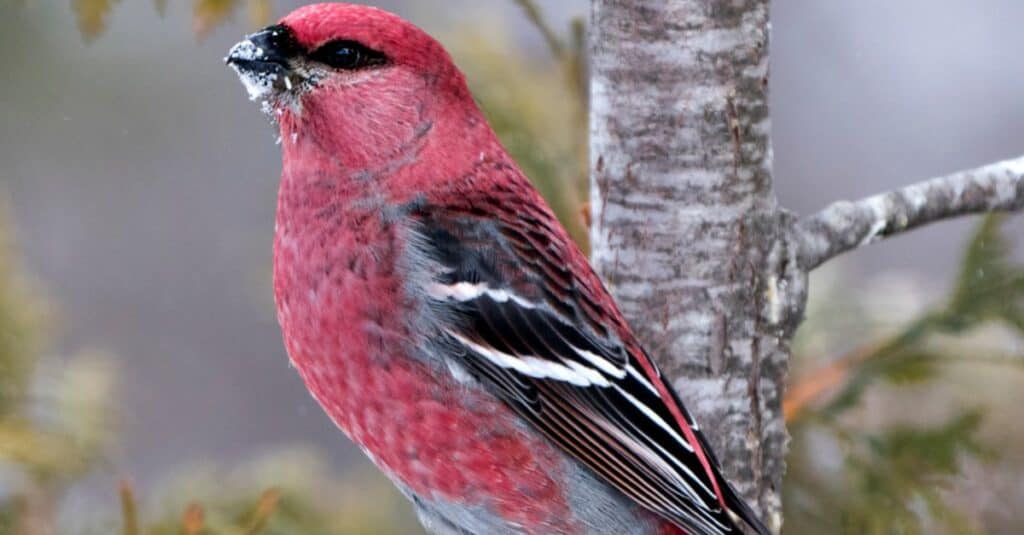
The pine grobeak features white bars on its wings, unlike the north cardinal.
©iStock.com/Rejean Bedard
The pine grosbeak is another member of the finch family, Fringillidae, and the only member of the genus Pinicola. Its name comes from its large beak which it uses to break apart the shells of pine seeds. They are distributed throughout Alaska, as well as northern Canada, Europe, and Russia. While the northern cardinal eats a varied diet, the pine grosbeak subsists mostly on fruits and some seeds. Additionally, pine grosbeaks mostly make their homes in coniferous forests, but cardinals live in several habitats. Unlike the northern cardinal, pine grosbeaks do not feature a black face mask or throat. Furthermore, they feature white bars on their wings which do not also appear on the wings of northern cardinals. Lastly, whereas the pine grosbeak features gray in its back and underparts, the northern cardinal has none. Based on these
#1: Pyrrhuloxia
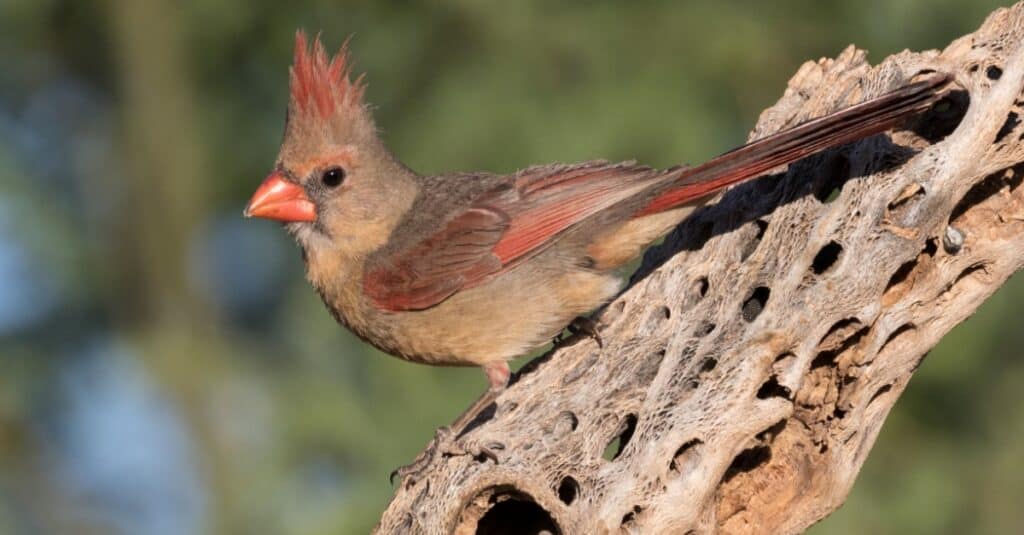
The desert cardinals is mostly gray with red markings, while the northern cardinal is mostly red with dark markings.
©iStock.com/Dee Carpenter Photography
Also known as the desert cardinal, the pyrrhuloxia is one of the best examples of birds that look like cardinals. It’s part of the same family and genus as the northern cardinal, making it a close relative. The pyrrhuloxia gets its name from the Greek words pyrrhos, or “reddish-orange,” and loxos, meaning “oblique.” These terms allude to its color, which matches a northern cardinal’s, and thick, conical bill. A native to the southwestern United States and Mexico, its range overlaps with the northern cardinal’s, as does its diet of fruits, seeds, and insects. The main difference between the two concerns their coloration. While the cardinal is mostly red with dark markings, the pyrrhuloxia is mostly gray with red markings. Take a cardinal and change its patterns to mostly gray with red markings, and it will look like a pyrrhuloxia. Based on this one feature, you can distinguish them from each other.
Summary of 6 Birds That Look Like Cardinals
| Number | Bird |
|---|---|
| 1 | Pyrrhuloxia |
| 2 | Pine Grosbeak |
| 3 | Summer Tanager |
| 4 | Red Crossbill |
| 5 | Scarlet Tanager |
| 6 | Vermillion Flycatcher |
The photo featured at the top of this post is © Bonnie Taylor Barry/Shutterstock.com
Thank you for reading! Have some feedback for us? Contact the AZ Animals editorial team.







